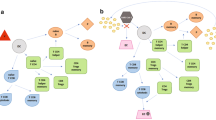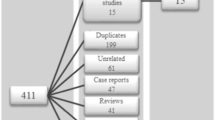Abstract
The novel coronavirus which emerged in Wuhan province of China has taken world by surprise. Since been diagnosed in December 2019, it has been termed a “Pandemic” and there is a growing concern in physicians across the globe. As new evidence is emerging, there are various preventative strategies which are being deployed. Multiple sclerosis patients who are on disease modifying therapies (DMTs) might be at a higher risk of acquiring or a poorer outcome due to their immune status. This review looks at the available evidence in managing this global crisis.
Similar content being viewed by others
Background
Coronavirus (COVID-19) has been termed as a global pandemic by the World Health Organization after being first diagnosed in December 2019 (https://www.who.int/emergencies/diseases/novel-coronavirus-2019/events-as-they-happen). The number of people infected with the virus is rising at an exponential rate with data from the World Health Organization (WHO) being updated regularly (https://www.who.int/emergencies/diseases/novel-coronavirus-2019/situation-reports). The mortality rate is reported to be between 1 and 5% [1,2,3].
There is a growing concern in physicians across specialities as the situation is evolving. A practicing neurologist is facing a difficult clinical decision in relation to disease modifying therapies in multiple sclerosis and to the risk of COVID-19.
Virology
The coronavirus that is linked to COVID-19 is from a family of Betacoronavirus which is from the same subgenus that caused the severe acute respiratory syndrome (SARS) virus. There is a structural similarity between the receptor-binding sites. Angiotensin-converting enzyme 2 (ACE-2), for viral entry, is the proposed binding region [4].
Immune response in COVID-19
The cytokine response to COVID-19 yielded a rise in inflammatory cytokines (tumor necrosis factor (TNF)-α, interleukin (IL)-2R, and IL-6) [5].
Similarly, the cell response in COVID-19 patients showed a decrease in lymphocyte subsets B cells, T cells, and natural killer cells [5]. There was a lower level of helper T cells and memory helper T cells while an increased percentage of naïve helper T cells in patients who had severe disease [5]. Patients with COVID-19 also have lower level of regulatory T cells, and more obviously damaged in severe cases [5].
Both the rise in inflammatory cytokines and decrease in cell counts were related to the severity of the disease [5].
Disease modifying therapies
There are many disease modifying treatments that are available at present with difference in their mechanism of action, as shown in Table 1.
At present, the evidence is in its preliminary phase for what is safe and what might pose an increased risk for acquiring the COVID-19 infection and may lead to severe form of the disease. The Association of British Neurologists released guidelines dividing disease modifying therapies into risk groups (https://cdn.ymaws.com/www.theabn.org/resource/collection/6750BAE6-4CBC-4DDB-A684-116E03BFE634/ABN_Guidance_on_DMTs_for_MS_and_COVID19.pdf). These risk groups are shown in Table 1:
- 1.
Safe to start or continue. Patients who are being started or already on interferon beta 1a, interferon beta 1b, glatiramer, teriflunomide, and dimethyl fumarate should continue it.
- 2.
Safe to start or continue with highest efficacy. Natalizumab may be considered a highly effective and safe choice in the perspective of COVID-19. It may be considered in patients with high-disease activity.
- 3.
Moderate risk. Fingolimod may increase the risk of acquiring COVID-19 or presenting with severe form of the disease; however, stopping it may get a rebound, so in these patients, benefits of continuing outweigh the risk. We do recommend these patients should be explained of these risks.
- 4.
Significant risk. Alemtuzumab, ocrelizumab, rituximab, and Cladribine may increase the risk of acquiring and severity of COVID-19. They should be carefully considered before starting in new patients and those who are scheduled for their next infusions.
- 5.
Could pose a significant risk. Ofatumumab and siponimod are not yet available in the UK or Ireland but might pose a significant risk.
Hematopoietic stem cell transplantation
Undertaking HSCT may pose a significant risk to the patient and should be deferred at present considering the risk of serious COVID-19-related infection (https://cdn.ymaws.com/www.theabn.org/resource/collection/6750BAE6-4CBC-4DDB-A684-116E03BFE634/ABN_Guidance_on_DMTs_for_MS_and_COVID19.pdf).
Active COVID-19 infection
In relation to active COVID-19 infection, a discontinuation or delay of any form of disease modifying therapy should be considered (https://cdn.ymaws.com/www.theabn.org/resource/collection/6750BAE6-4CBC-4DDB-A684-116E03BFE634/ABN_Guidance_on_DMTs_for_MS_and_COVID19.pdf).
Discussion
The current recommendation by the Association of British Neurologists (ABN) lacks class 1 evidence (https://cdn.ymaws.com/www.theabn.org/resource/collection/6750BAE6-4CBC-4DDB-A684-116E03BFE634/ABN_Guidance_on_DMTs_for_MS_and_COVID19.pdf). The COVID-19 pandemic at present is expanding at an alarming rate, which may put these multiple sclerosis patients at a higher risk due to their immune status. The data from the World Health Organization (WHO) has not yet been translated in relation to this cohort of COVID-19 patients who are on disease modifying therapies. The risk estimate for the multiple sclerosis patients therefore still remains unknown.
Recommendation
We recommend a careful consideration of disease modifying therapies in the current health crisis which is still unfolding. In relation to multiple sclerosis, we strongly urge clinicians to educate patients on disease modifying therapies and a potential risk of COVID-19. Patients should be urged to follow strict preventative measures and if possible to postpone or defer potentially high-risk disease modifying treatments.
References
"Coronavirus Age, Sex, Demographics (COVID-19) - Worldometer". www.worldometers.info.
"Wuhan Coronavirus Death Rate - Worldometer". www.worldometers.info.
"Report 4: Severity of 2019-novel coronavirus (nCoV)"(PDF).
Zhou P, Yang XL, Wang XG, Hu B, Zhang L, Zhang W, et al. A pneumonia outbreak associated with a new coronavirus of probable bat origin. Nature. 2020 Mar;579(7798):270–3.
Qin C, Zhou L, Hu Z, Zhang S, Yang S, Tao Y, et al. Dysregulation of immune response in patients with COVID-19 in Wuhan. Clinical Infectious Diseases: China; 2020 Mar 12.
Arnon R, Sela M. The chemistry of the Copaxone drug. Chem. Isr. 1999;1:12–7.
Bar-Or A, Pachner A, Menguy-Vacheron F, Kaplan J, Wiendl H. Teriflunomide and its mechanism of action in multiple sclerosis. Drugs. 2014 Apr;74(6):659–74.
Kieseier BC. The mechanism of action of interferon-β in relapsing multiple sclerosis. CNS Drugs. 2011 Jun 1;25(6):491–502.
Brück J, Dringen R, Amasuno A, Pau-Charles I, Ghoreschi K. A review of the mechanisms of action of dimethylfumarate in the treatment of psoriasis. Exp Dermatol. 2018 Jun;27(6):611–24.
Hutchinson M. Natalizumab: A new treatment for relapsing remitting multiple sclerosis. Ther Clin Risk Manag. 2007 Jun;3(2):259–68.
Chun J, Hartung H. Mechanism of action of oral fingolimod (FTY720) in multiple sclerosis. Clinical Neuropharmacology. 2010 Mar;33(2):91–101.
Ruck T, Bittner S, Wiendl H, Meuth SG. Alemtuzumab in multiple sclerosis: mechanism of action and beyond. Int J Mol Sci. 2015 Jul 20;16(7):16414–39.
Cerny T, Borisch B, Introna M, Johnson P, Rose AL. Mechanism of action of rituximab. Anticancer Drugs. 2002 Nov;13(Suppl 2):S3–10.
Behrangi N, Fischbach F, Kipp M. Mechanism of siponimod: anti-inflammatory and neuroprotective mode of action. Cells. 2019;8(1):E24.
Acknowledgements
Not applicable
Author information
Authors and Affiliations
Contributions
SM, SK, AW, KM, and NS were involved in the writing of the manuscript and in diagnosing and treating the patient. The author(s) read and approved the final manuscript.
Corresponding author
Ethics declarations
Ethics approval and consent to participate
All authors have confirmed that this study did not involve animal subjects or tissue.
Consent for publication
Not applicable
Competing interests
In compliance with the ICMJE uniform disclosure form, all authors declare the following: Payment/services info. All authors have declared that no financial support was received from any organization for the submitted work.
Financial relationships. All authors have declared that they have no financial relationships at present or within the previous 3 years with any organizations that might have an interest in the submitted work.
Other relationships. All authors have declared that there are no other relationships or activities that could appear to have influenced the submitted work.
Additional information
Publisher’s Note
Springer Nature remains neutral with regard to jurisdictional claims in published maps and institutional affiliations.
Rights and permissions
Open Access This article is licensed under a Creative Commons Attribution 4.0 International License, which permits use, sharing, adaptation, distribution and reproduction in any medium or format, as long as you give appropriate credit to the original author(s) and the source, provide a link to the Creative Commons licence, and indicate if changes were made. The images or other third party material in this article are included in the article's Creative Commons licence, unless indicated otherwise in a credit line to the material. If material is not included in the article's Creative Commons licence and your intended use is not permitted by statutory regulation or exceeds the permitted use, you will need to obtain permission directly from the copyright holder. To view a copy of this licence, visit http://creativecommons.org/licenses/by/4.0/.
About this article
Cite this article
Mansoor, S., Kelly, S., Murphy, K. et al. COVID-19 pandemic and the risk of infection in multiple sclerosis patients on disease modifying therapies: “what the bleep do we know?”. Egypt J Neurol Psychiatry Neurosurg 56, 44 (2020). https://doi.org/10.1186/s41983-020-00177-0
Received:
Accepted:
Published:
DOI: https://doi.org/10.1186/s41983-020-00177-0




